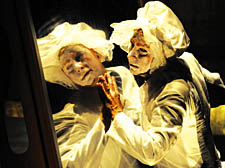|
|
 |
| |

Robert Lepage as Chevalier d’éon on stage at Sadler’s Wells |
Chevalier d’éon and a big night at theatre
New evidence of cross-dressing French knight’s grave is revealed as show attracts star names
THE principal ballet dancer was French, the director was Canadian, the funding from Geneva, and the audience a sparkling mix of the international jet set.
The great and good from around the globe – supermodel Erin O’Connor and celebrity chef Jamie Oliver among them – descended on Sadler’s Wells in Rosebery Avenue on Monday for the world premiere of Eonnagata.
But while they cooed over the Alexander McQueen costumes, the cross-dressing, real-life inspiration for the show lay buried in an unmarked grave less than a mile away.
It emerged this week that the notorious Chevalier d’éon, a soldier, spy and diplomat of the court of Louis XV, who spent the first half of his life as a man and his later years as a woman, was laid to rest in St Pancras churchyard upon his death in 1810.
The revelation, disclosed by Sadler’s Wells chief executive Alistair Spalding, grounds the production by ballerina Sylvie Guillem, theatre legend Robert Lepage and choreographer Russell Maliphant firmly on home territory.
Designer Alexander McQueen fitted the dramatic costumes at his head office in nearby Amwell Street.
Speaking to the Tribune on Wednesday, Mr Spalding said: “A friend of a colleague discovered it on a website register of all the graveyards in London and there he was. If it is there that would be really something. Robert Lepage had known this story for a long time and now it turns out there’s a geographical resonance with Sadler’s Wells.”
Historian Robert Hatch, who gives tours of the cemetery, said little was known about the fate of the Chevalier.
He died in poverty in King’s Cross, despite his aristocratic ties, though it was always supposed he was buried in Middlesex.
Mr Hatch said it was a “sad, lowly end for a man who had been in the pay of the King of France,” and suggested that St Pancras churchyard had been chosen by the dying Catholic knight because it was the last church in England to sound the bell for mass after the Reformation.
In a further twist, he
said, the Chevalier’s grave may be one of the 500 headstones to be dug up by the young writer Thomas Hardy during the construction of the Midland Railway Line into St Pancras in 1867.
The Chevalier’s final resting place could be beneath the cemetery’s famous Hardy tree, an ancient ash crowded by gravestones but, warned Mr Hatch, “it would be damned difficult to find out”.
Eonnagata, which ends on Sunday, but returns to Sadler’s Wells for a five-day run in June, centres on the Chevalier’s strange life. He was the first spy to use cross-dressing as a disguise and when he first arrived in England a bet ran for a year on the London Stock Exchange as to whether he was a man or a woman.
After Louis XV died, Louis XVI only allowed him to return to France on condition he lived the rest of his life dressed as a woman – agreeing to fund his wardrobe. In the advent of the French Revolution he fled back to England and spent his ageing days in circus acts, dressed as a dame.
Even after he died in 1810, there was still much speculation over his gender, until a post mortem finally proved he was male. |
 |
|
 |
|
| |
| |
|
 |
|